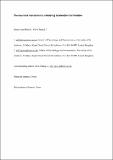Files in this item
The neuronal mechanisms underlying locomotion termination
Item metadata
| dc.contributor.author | Ritson, Emma Jean | |
| dc.contributor.author | Li, Wen-Chang | |
| dc.date.accessioned | 2020-02-07T00:35:17Z | |
| dc.date.available | 2020-02-07T00:35:17Z | |
| dc.date.issued | 2019-04 | |
| dc.identifier | 257627586 | |
| dc.identifier | 75382d40-24cd-4a85-892b-224d175ef890 | |
| dc.identifier | 85062515335 | |
| dc.identifier | 000471296600017 | |
| dc.identifier.citation | Ritson , E J & Li , W-C 2019 , ' The neuronal mechanisms underlying locomotion termination ' , Current Opinion in Physiology , vol. 8 , pp. 109-115 . https://doi.org/10.1016/j.cophys.2019.01.009 | en |
| dc.identifier.issn | 2468-8673 | |
| dc.identifier.uri | https://hdl.handle.net/10023/19424 | |
| dc.description.abstract | It is critical for animals to be able to stop locomotion according to their external and internal needs. Limited studies show there are dedicated neuronal pathways responding to either sensory inputs or commands from higher brain areas to inhibit the locomotor circuit and actively terminate locomotion. Such neuronal mechanisms are clearly demonstrated by the quick ending of ongoing locomotor rhythms following the activation of “stop” cells in the brainstem. In contrast, some activity-dependent mechanisms intrinsic to the locomotor neuronal network are responsible for the spontaneous ending of locomotor episodes. Known autonomous mechanisms involve the release/accumulative production of adenosine or the mediation of long-lasting hyperpolarisation by Na+ pumps following locomotion. We discuss some recent studies that have led to these findings. | |
| dc.format.extent | 7 | |
| dc.format.extent | 647384 | |
| dc.language.iso | eng | |
| dc.relation.ispartof | Current Opinion in Physiology | en |
| dc.subject | Locomotion | en |
| dc.subject | CPG | en |
| dc.subject | Brainstem | en |
| dc.subject | Stop cells | en |
| dc.subject | RC0321 Neuroscience. Biological psychiatry. Neuropsychiatry | en |
| dc.subject.lcc | RC0321 | en |
| dc.title | The neuronal mechanisms underlying locomotion termination | en |
| dc.type | Journal item | en |
| dc.contributor.institution | University of St Andrews. School of Psychology and Neuroscience | en |
| dc.contributor.institution | University of St Andrews. Institute of Behavioural and Neural Sciences | en |
| dc.identifier.doi | https://doi.org/10.1016/j.cophys.2019.01.009 | |
| dc.description.status | Peer reviewed | en |
| dc.date.embargoedUntil | 2020-02-07 |
This item appears in the following Collection(s)
Items in the St Andrews Research Repository are protected by copyright, with all rights reserved, unless otherwise indicated.

